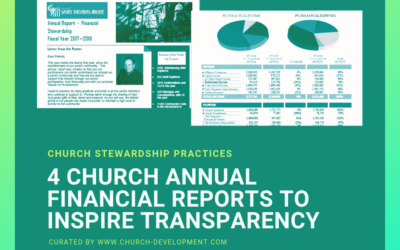Our goal is to help you build an ongoing culture of generosity in your church. The following list are 7 underlying values of The Stewardship System™ to highlight in building your stewardship ministry. These values are based on research and experience. Each value should be supported with specific activities. Use this list with your stewardship committee to determine what you want to accomplish with your ministry. For a printable version of this, and discussion questions to guide your planning, check out our stewardship strategic planning guide.
Culture of Stewardship Checklist
Build these ministry programs or offerings into your annual stewardship plan:
- Teach Stewardship
- Engage Members as Volunteers
- Connect People Socially
- Share Decision Making
- Teach Prayer and Discernment
- Ask for Support
- Give Thanks
1. Teach Stewardship
Many people hear the word “stewardship” or “giving” and think money. It’s so much more than that! A well-rounded understanding of the meaning of Christian stewardship helps people to make decisions that are in line with their values. Invite parishioners into a deeper understanding of the spirituality of stewardship by educating them:
- Invite lay speakers to share “How God has blessed me” in worship, at events, or via video (email or post on your social media sites).
- Include weekly stewardship reflections and a monthly newsletter column in your bulletin (The Stewardship System can give you everything you need).
- Preach on the meaning of stewardship (4 times per year).
- Offer Personal Financial Education classes at least once a year.
- Offer an Estate Planning Workshop.
- Offer a financial coaching ministry.
Lay speakers’ witness is the most effective means of teaching stewardship.
2. Engage Disciples as Volunteers
A church member who volunteers is 11x more likely to participate financially in a capital campaign. Barna Group’s report, The Generosity Gap, confirms that this correlation extends to all financial giving, not just in capital campaigns. This should not be surprising if you understand the spirituality of stewardship. We recommend building in many opportunities in your parish life for people to live their discipleship through giving their time.
- Offer a wide array of diverse episodic volunteer opportunities (one time!) to engage those who are someone on the margins of your community. These don’t need to be complicated or require a lot of organizing. Ask your ministry leaders what they need help with and I bet you’ll have an endless list before you know it!
- Host a spiritual gifts workshop: Sometimes people need a intentional time of prayer and some guidance to discover what God is calling them to. A workshop on gifts and discernment can broaden the understanding of vocation through asking “What are your spiritual gifts and how do you feel called to share those with the world?”
- Hold a ministry fair once a year to highlight all the ministries offered in your church.
3. Connect People Socially
Technology is on the rise and daily life is busy. Yet people are more lonely than ever. The church is God’s gift to the world to help us live this joyous and sometimes difficult life. Your parish community can be a soup kitchen for those who are starving for real connection. When people are connected socially, they see the personal benefit of their church and are more likely to support it financially.
- Offer fellowship opportunities after worship – donuts and coffee anyone?
- Host pot luck dinners to celebrate special events or “just because” (no fundraising or asking for donations at these events!).
- Develop a welcoming/hospitality ministry with your extroverted, friendly volunteers. No one should walk into your church for the first (or second, or fifty-seventh) time without a greeting from a real person.
- Develop a small group ministry. Chances are you are probably already doing this but didn’t consider it to be a part of your stewardship efforts. #winning
- Hold a few church-wide community projects/events each year.
- Offer swag (t-shirts, coffee mugs, hats, etc) branded with your church logo or mission statement that remind people they belong when they are not at the church on Sunday.
- Solicit a communications staff person or a tech-savvy volunteer to start or manage a social media account for your church to keep people informed of opportunities to connect.
4. Share Decision Making
Church members give more when they are actively involved in the life of the church, and they are more likely to take personal responsibility for decisions in which they have had a say. To facilitate share decision making among your people:
- Invite members to lunch with the pastor once a year. Have a facilitator present to gather feedback on this question: “What could we do better as a church?”
- Hold town hall meetings to gather feedback and ideas about solving a problem the church is facing.
- Send out a survey to gather feedback on issues affecting the life of the church. (a stewardship survey is provided in the Hope Grows Here Annual Campaign).
- Publish annual financial statements in the bulletin.
- Offer complete transparency in church financial dealings (transparency builds trust).
- Have all board/financial meetings open to the public.
5. Teach Prayer and Discernment
For many people, prayer is “asking for what I need”.
Stewardship is rooted in gratitude for the blessings we have already been given. Teaching gratitude through reflection and prayer can change a person’s life! When a faithful person starts looking at everything they have, instead of what they don’t, the natural response is “what am I supposed to do with this abundance?”.
- Offer classes/workshops teaching prayer and discernment (twice a year).
- Annually, gather prayer requests for a season of prayer and thanksgiving.
- Have a team call each household in your church and ask for prayer requests.
- Publish a 7 or 14-day prayer guide with your annual campaign materials. This should include short 1-2 paragraph stories from lay people sharing how God showered them in abundance when they were generous.
6. Ask for Support
Host 4 appeals during the year – not 52. Keeping your solicitations to a minimum prevents donor fatigue and encourages participation for everyone. We have some samples you can view if you’re not sure what to say. Your four yearly asks should include:
- Annual stewardship campaign – This is your big ask for the year to support your annual budget. Build into the budget your tithing to community projects or partners that your parish supports to avoid regular, small appeals throughout the year (we offer a comprehensive guide, based on best practices to kick start your annual campaign effort).
- Capital Appeal Letter – some people are very concrete thinkers and like to have a tangible outcome to their donation. Give them an opportunity to sponsor a roof tile, parking space, or fellowship hall table.
- “Emergency” Appeal Letter – Barna’s study, The Generosity Gap, unveiled that millennials are more likely than older generations to see generosity as “spur of the moment”. They need an urgent need to prompt a response. Plan a way to invite them to save the day.
- Year-end Appeal Letter – 10% of most organizations’ annual income comes from a year-end solicitation. You may have a low participation rate, but for your top 10-12 donors, they need this reminder to invite their collaboration while reducing their tax liability.
Offer electronic giving options for the 50% of your church that doesn’t carry cash or checks. If you’re not sure where to start with that download our introductory guide to electronic giving.
7. Thank your supporters
Who would we be if we did not practice what we preached? As we invite our friends to recognize God as the source of all blessings, so too are we called to give thanks. We are thankful for the blessings God has bestowed upon our ministries through the people who support it with their resources.
- Send quarterly thank you letters with a statement of gifts to date (here is an example).
- Periodically send a handwritten note from a stewardship committee member or the pastor.
- When appropriate, give a gift to those who pledge or give to a campaign.
- Hold a volunteer recognition banquet one month before your annual campaign Commitment Sunday.
Give it some time
The above strategies are proven through research and our experience to make a difference in annual giving. They shift the mindset of your members to understand stewardship as more than fundraising. Cultural shifts take time – so don’t be discouraged if it takes a few months to start noticing a difference. One way to stay encouraged is by tracking your giving and measuring change over time. For a guide on using this blog post as a discussion and planning tool with your stewardship committee download our Stewardship Strategic Planning Guide and Checklist. Then subscribe to The Stewardship System for regular accountability in growing giving at your church.



